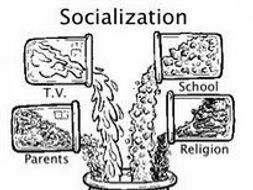 How can one's culture affect the emotional distress in an individual? For adolescents, the use of goal-setting has provided a glimpse into the possibility that culture has an effect on the emotional distress experienced by the adolescent. The role of the parent in goal-setting has caused some speculation that parents socialize the type of goals they want in their child, which originally sees the parent socialized by their cultural views and how their respective culture emphasizes different goal-setting methods. In turn, some goal-setting methods may be more susceptible to causing more emotional distress in an individual.
How can one's culture affect the emotional distress in an individual? For adolescents, the use of goal-setting has provided a glimpse into the possibility that culture has an effect on the emotional distress experienced by the adolescent. The role of the parent in goal-setting has caused some speculation that parents socialize the type of goals they want in their child, which originally sees the parent socialized by their cultural views and how their respective culture emphasizes different goal-setting methods. In turn, some goal-setting methods may be more susceptible to causing more emotional distress in an individual. Individualist vs. Collectivist cultures
Individualist cultures emphasize the individual and the need for personal growth, with less emphasis on the needs of the community coming before the individual. This type of culture is mostly seen in North America (as the main association with the culture is narcissism),and the goal-setting method associated with individualist cultures are self-worth goals. These goals aim to improve the self-esteem of the individual by focusing on their strengths and focusing less on what they need to improve. Self-worth goals may decrease the emotional distress of an adolescent, but they are not as strong when trying to improve academics. Collectivist cultures emphasize the needs of the group over the individual, with pop-culture often referencing Asian cultures and the importance of Honour because it provides respectability within a community. Self-improvement goals are the main method of collectivist cultures, with emphasis on the improvement of weaknesses directly and less acknowledgement of the individual's strengths. This method may provide improvements to the adolescent's academics, but the method may enhance emotional distress in an adolescent.
Adolescents and their Vulnerability to Emotional Distress
 The adolescent demographic is very vulnerable to emotional distress and other psychological issues. This is a period in one's life that many changes and developmental experiences are at the forefront, so the stress of these changes can become quite overwhelming. 30% of adolescents will report that they are anxious or depressed by the experiencing of adolescent stress (Bethune, 2014). Suicide is also the second leading killer among adolescents (WHO, 2016). Academics can become stressful for adolescents as their is an urge from within themselves and from socializing forces like their parents to find some academic success. For an adolescent to struggle, they might fear falling behind academically because of the certain goals they set for themselves. By continually striving for improvement, an adolescent might become burnt-out with constantly trying to improve, but might also lack the emotional support that comes with self-worth goals.
The adolescent demographic is very vulnerable to emotional distress and other psychological issues. This is a period in one's life that many changes and developmental experiences are at the forefront, so the stress of these changes can become quite overwhelming. 30% of adolescents will report that they are anxious or depressed by the experiencing of adolescent stress (Bethune, 2014). Suicide is also the second leading killer among adolescents (WHO, 2016). Academics can become stressful for adolescents as their is an urge from within themselves and from socializing forces like their parents to find some academic success. For an adolescent to struggle, they might fear falling behind academically because of the certain goals they set for themselves. By continually striving for improvement, an adolescent might become burnt-out with constantly trying to improve, but might also lack the emotional support that comes with self-worth goals. How can goal-setting silence the emotional distress influenced by culture? To silence one's culture, the individual would need to put less emphasis on the predominate behaviours of that culture. By incorporating a hybrid self-worth and self-improvement goal-setting strategy, the role of parents or other socializing forces would be to foster principles of both methods. This strategy would include self-improvement principles that aim to better the individual's academic performance, but also include the self-worth principles that acknowledge one's strengths and provides emotional support. Taking the example of an academic environment, an instructor or teacher might dedicate a period of time to talking about an individual's strengths on an assignment or evaluation, after participating in constructive feedback measures that are aimed at improving an individual's weaknesses on a task.
Benefits of Hybrid Goal-Setting
- Adolescents get the feedback they need to improve but also the support of authority figures when completing tasks
- Emotional distress is decreased or balanced so that adolescent mental health issues decline
- Eliminate some of the stress associated with being an adolescent, helping the adolescent function without burn-out and reach their potential
- Foster a collaborative learning program that improves the student academically while caring for the emotional state of the student
Bethune, S. (2014, April). Teen stress rivals that of adults. Retrieved from
https://www.apa.org/monitor/2014/04/teen-stress.
https://www.apa.org/monitor/2014/04/teen-stress.
Ng, J., Xiong, Y., Qu, Y., Cheung, C., Ng, F. F., Wang, M.,
& Pomerantz, E. M. (2019).
Implications of chinese and american mothers’
goals for children’s emotional distress. Developmental Psychology, 55(12),
2616-2629. doi:10.1037/dev0000834


No comments:
Post a Comment